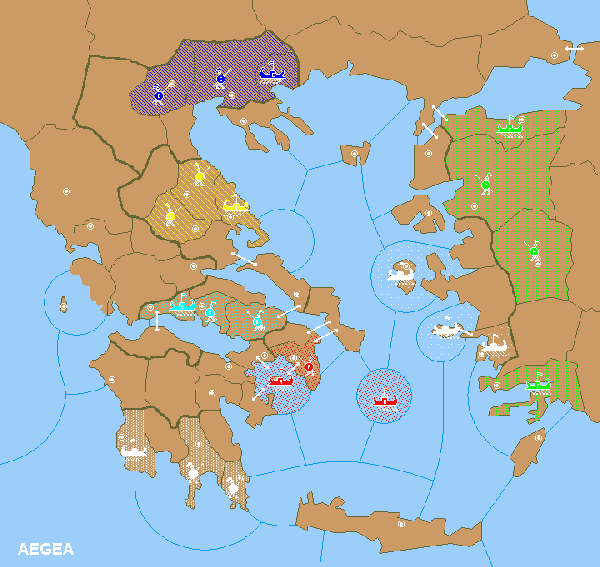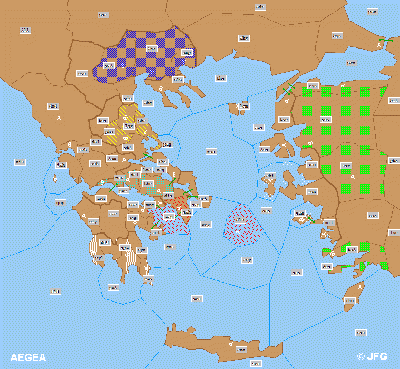Difference between revisions of "Aegean"
| (3 intermediate revisions by the same user not shown) | |||
| Line 1: | Line 1: | ||
==Rules== | ==Rules== | ||
| + | [[Image:Aegean.gif|600px|thumb|right]] | ||
1) Except as noted below, the standard rules of play for Diplomacy apply. | 1) Except as noted below, the standard rules of play for Diplomacy apply. | ||
| Line 12: | Line 13: | ||
20 centers at the end of any Fall retreat. | 20 centers at the end of any Fall retreat. | ||
| − | |||
5) There are seven great powers. The starting units are as follows: | 5) There are seven great powers. The starting units are as follows: | ||
| Line 20: | Line 20: | ||
*F Delos | *F Delos | ||
| + | [[Image:Aegean_RP.gif|600px|thumb|right]] | ||
B-BOEOTIA | B-BOEOTIA | ||
*A Thebes | *A Thebes | ||
| Line 52: | Line 53: | ||
6) A player may build on any supply center he owns which is vacant as | 6) A player may build on any supply center he owns which is vacant as | ||
| − | long as he still owns at least one of his original centers ([[Aberration | + | long as he still owns at least one of his original centers ([[Aberration Builds]]). |
| − | Builds]]). | ||
7) All the coastal provinces have one unique coast. | 7) All the coastal provinces have one unique coast. | ||
| − | |||
8) 12 bridges connect some islands with continent, or close coastal | 8) 12 bridges connect some islands with continent, or close coastal | ||
territories. A moving unit (fleet or army) using a bridge doesn't | territories. A moving unit (fleet or army) using a bridge doesn't | ||
effect any fleet moving in the see spaces crossed by the bridge. | effect any fleet moving in the see spaces crossed by the bridge. | ||
| + | [[Image:Aegean10 Names.gif|400px|thumb|right]] | ||
These bridges connect the following provinces: | These bridges connect the following provinces: | ||
*byz - phr | *byz - phr | ||
Latest revision as of 20:55, 18 June 2010
Rules
1) Except as noted below, the standard rules of play for Diplomacy apply.
2) This game is played on a map representing the Aegean Sea during the Vth and IVth centuries BC.
3) Game starts in Spring 475 BC, soon after the Medic Wars. The game is calculated in years after the first Olympic games in 776 BC, so the game starts in S301M.
4) There are 38 supply centers. The victory condition is possession of 20 centers at the end of any Fall retreat.
5) There are seven great powers. The starting units are as follows:
A-ATHENS
- A Athens
- F Aegina
- F Delos
B-BOEOTIA
- A Thebes
- A Delphi
- F Naupactus
I-IONIA
- F Miletus
- F Chios
- F Samos
M-MACEDONIA
- A Pella
- A Therma
- F Amphipolis
P-PERSIA
- A Sardes
- F Cyzicus
- A Pergamum
- F Halicarnassus
S-SPARTA
- A Sparta
- F Pylos
- A Zarax
T-THESSALIA
- A Pharsalus
- A Larissa
- F Pherae
6) A player may build on any supply center he owns which is vacant as long as he still owns at least one of his original centers (Aberration Builds).
7) All the coastal provinces have one unique coast.
8) 12 bridges connect some islands with continent, or close coastal territories. A moving unit (fleet or army) using a bridge doesn't effect any fleet moving in the see spaces crossed by the bridge.
These bridges connect the following provinces:
- byz - phr
- thr - cyz
- thr - tro
- the - cha
- sam - mil
- pht - cha
- dia - eub
- ath - eub
- nau - ach
- act - aeg
- ath - aeg
- meg - aeg
9) The unnamed spaces as Corcyra for example are not usable for units.
10) Six supply centers are islands surrounded by sea, so they are both land and see territories. Fleets can move normally to these islands, and a fleet which is in an island can make a convoy. To move to an island, an army must be convoyed, or use a bridge. Ithaca is an exception: because this center includes continental territory, an army in Ambracia or Aetolia can move to Ithaca normally. These island centers are Ithaca, Aegina, Delos, Lesbos, Chios and Samos.
Map Abbreviations
One-word territory names are abbreviated by their first three letters, except the following:
Olynthus olt Therma thm Delos dls
Two-words territory names are abbreviated by the first two letters of the first word, and the initial of the second, except the following:
Pontus Euxinus pon North Sporades nsp South Sporades ssp West Cyclades wcy East Cyclades ecy
Three-words territory names are abbreviated by the three initials.
Historical Background
499 BC : The cities of the Ionian League, which had developped a brillant civilization in the course of the earlier centuries, rebel against the Persian rule under the command of tyrant Aristagoras of Miletus. Darius, king of Persia, squelches the revolt and attempts to dominate the Greek cities on the continent.
490 BC : First Medic war. Athens defeats the Persian army in Marathon, near Athens. Xerxes, son of Darius, prepares for a great expedition while the Greeks attempt to unite under Spartan rule.
480 BC : Second Medic war. Xerxes subjects Northern Greece, crushes Leonidas's heroïc Spartan army in Thermopylae (East Locris). Athens is destroyed by fire. But the Persian fleet is vanquished in Salamis (Aegina Gulf) by Themistocles, commander of the Athenian fleet. The next year, the Spartan army (led by Pausanias) defeats the Persian troops in Plataea, Boeotia. Greece is freed from the Persian yoke.
479-431 : The Golden Years of Athens: most of the cities of the Aegean coasts are brought together in a "Delos League" which soon develops so as to form the Empire of Athens. Meantime, most of the Southern cities are federated in the "Peloponnesian League" under Spartan rule. Numerous conflicts exist between these two alliances.
431-404 : The Peloponnesian war sets the Spartan League (which is also allied to Thebes) against the Empire of Athens, led by Pericles and later on by Alcibiade. Lysandre, naval commander of Lacedemonians, destroys the Athenian fleet, the walls of Athens are razed to the ground and the Delos league is broken up.
The IVth century : The turn of the century is marked by the Spartan hegemony, led by king Agesilas, but it is soon disputed by Athens (which forms another confederation) and Thebes, which brings together the Boeotian League, while Jason of Pherae unifies Thessaly under his rule. In 371, Epaminondas, the leader of the Theban army, beats the Spartans in Leuctra, in Boeotia, but Epaminondas is killed in the battle of Mantinea (Arcadia) against the Athens-Sparta coalition in 362.
After Mantinea, the three hegemonic cities start to weaken while, in the North, the powerful kingdom of Macedonia is forming. Philippe II (356-336) unifies his territory, raises a powerful army and becomes the leader of the Thessalian league around 344. He becomes more and more involved in Greek affairs. In 338, in Coronea (Boeotia), he defeats the Thebans, Athenians and their allies and imposes peace as the leader of the whole Greece.
His son, Alexander the Great (336-324) can now set out to conquer the Persian Empire...


